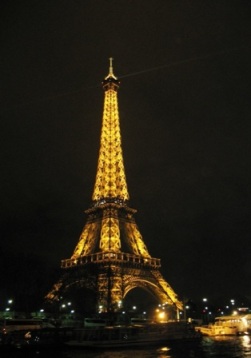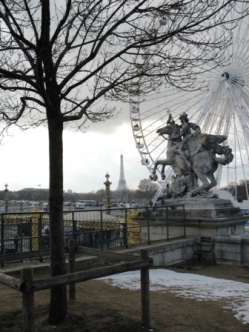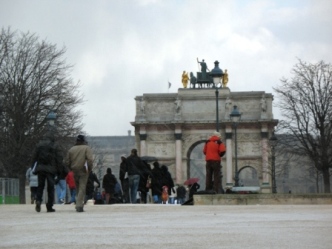|
Paris Family Vacations Include Street Theatre, Asterix, and Monet's Garden .  Paris may be known as the romantic heart of Europe, but its appeal is multi generational. From the Eiffel Tower to the Louvre the city is a feast for the senses of both the young and the young at heart - think Beauty and the Beast and Hunchback of Notre Dame. It is a place to ride a pony in the park; sample scrumptious pastries, cheese, fresh bread, and wine. From Astrix, kid-cinemas and cirques to biking and in-line skating, Paris is magical for young children. For teens it is MTV times ten and for families it is fun. Paris may be known as the romantic heart of Europe, but its appeal is multi generational. From the Eiffel Tower to the Louvre the city is a feast for the senses of both the young and the young at heart - think Beauty and the Beast and Hunchback of Notre Dame. It is a place to ride a pony in the park; sample scrumptious pastries, cheese, fresh bread, and wine. From Astrix, kid-cinemas and cirques to biking and in-line skating, Paris is magical for young children. For teens it is MTV times ten and for families it is fun.
Who else has an Eiffel Tower? Like the Statue of Liberty is New York, Big Ben is London, the Kremlin is Moscow, the Eiffel Tower is Paris. For two years French engineer Gustave Eiffel -- already famous for building viaducts and bridges -- worked to erect this monument to symbolize the birth of technology. The Eiffel Tower's engineering is amazing. Even in the strongest winds the tower never sways more than 4½ inches. The view is most breathtaking at night, when every girder is highlighted in a sparkling display. Need to know: You can take the stairs as far as the third floor, but if you want to go to the top you'll have to take the elevator. The view at 1,000 feet may not beat that from the Tour Montparnasse skyscraper, but the setting makes it considerably more romantic, more vintage Paris. (Tour Eiffel, Paris. 0144112323 or www.tour-eiffel.fr)
Looking for Linnea? One of the city's secrets, the Musée Marmottan-Claude Monet is Paris's "other" Impressionist museum (after the Musée d'Orsay). The museum houses of the foremost collections of Claude Monet ’ s work anywhere; it occupies a specially built basement gallery, where you'll find such captivating works as the series (1892-96) and (1872), and the work that helped give the Impressionist movement its name. There's a roomful of priceless illuminated medieval manuscripts on the ground floor, and many more rooms full of beautiful artistic treasures. Bonus Points: The obvious connection for kids is the ever-popular children's book Linnea in Monet's Garden. Even without Mr. Bloom as a guide selecting a favorite Monet makes a visit a one-of a kind experience. (2 rue Louis-Boilly, Paris. 0144965033 or www.marmottan.com)
“These Gauls are crazy!” Every spring the gates of Parc Astérix swing open to revel a giant theme park nestled in the heart of a protected forest to the northeast of Paris. Visitors will travel through ancient Gaul, the Roman Empire and the Middle Ages – all the way to the 21st century. With 30 permanent rides, regular shows, and costumed performers, Parc Astérix is a wonderful way for the whole family to escape. Need to know: It’s easy to get to Parc Astérix, just take the underground, the train, or the bus north of Paris; it’s only 22 miles away, and the website offers details on various offers available to visitors, as well as detailed directions. (Parc Astérix, BP8, 60128, Plailly. (03) 4462 3404 or 4462 3030 or www.parcasterix.com)
Visit the next frontier. Always a great field trip with kids, the Cité des Sciences et de l ’ Industrie – La Villette is hosting Star Wars, l'expo. This is the place to take the kids on a trip through space that peeks behind the scenes of all six episodes, features the planets Tatooine, Naboo, Coruscant and Geonosis and presents more than 150 original objects used in filming: models, puppets, painted miniatures and costumes. Film and video clips demonstrate the development of the special effects used, from the more traditional to the most cutting-edge. You can even hear the view of an astrophysicist who will help you to decode certain related scientific teasers. (Cité des Sciences et de l ’ Industrie – La Villette. Parc de la Villette 30, avenue Corentin Cariou 75019 Paris www.cite-sciences.fr)
Everyone loves a surprise.  If you are lucky enough to be in Paris on the second Sunday of any month then Pochette Surprise (Lucky Bag) is an option. It is a showing of family friendly short films. Mostly silent films from the opening decades of cinema, they range from slapstick to quirky documentaries and cartoons. These “ Pochette Surprise ” sessions last an hour and a half and will delight fans, while at the same time introducing ever-wider audiences to a slice of cinematic history rarely seen on the TV screen and giving kids the chance to see a real live show. Bonus Points: The added extra of this family entertainment is the live piano accompaniment which serves to highlight the magic of these early films. See the first screen stars including Charlie Chaplin, Laurel and Hardy, Buster Keaton and laugh while watching some amusing Tex Avery. Great fun and an easy outing with kids. (Cinema Le Balzac 1, rue Balzac 75008 Paris www.cinemabalzac.com) If you are lucky enough to be in Paris on the second Sunday of any month then Pochette Surprise (Lucky Bag) is an option. It is a showing of family friendly short films. Mostly silent films from the opening decades of cinema, they range from slapstick to quirky documentaries and cartoons. These “ Pochette Surprise ” sessions last an hour and a half and will delight fans, while at the same time introducing ever-wider audiences to a slice of cinematic history rarely seen on the TV screen and giving kids the chance to see a real live show. Bonus Points: The added extra of this family entertainment is the live piano accompaniment which serves to highlight the magic of these early films. See the first screen stars including Charlie Chaplin, Laurel and Hardy, Buster Keaton and laugh while watching some amusing Tex Avery. Great fun and an easy outing with kids. (Cinema Le Balzac 1, rue Balzac 75008 Paris www.cinemabalzac.com)
Take a modern view. Like the more widely known Pompidou, the Paris Museum of Modern Art shows temporary exhibits of painting, sculpture, and installation and video art, plus a permanent collection of top-tier 20th-century works from around the world – and it happily escapes the Pompidou's overcrowding. The Paris Museum of Modern Art takes over, chronologically speaking, where the Musée d'Orsay leaves off; among the earliest works are Fauvist paintings by Maurice Vlaminck and André Derain, followed by Pablo Picasso's early experiments in Cubism. (11 av. du Président-Wilson, Paris. 0153674000, or Paris Museum of Modern Art or www.paris.org)
Seen any Picassos? Kids either love Picasso's works or show no affinity. This museum adventure needs to done after a snack, no low blood sugar attitudes. Relatively new as museums go, The Picasso Museum opened in 1985 and is popular, mainly because in one location it houses not his masterpieces but his life's work. That makes it the largest collection of works by Picasso in the world. Described as his personal collection, that is "Picasso's Picassos," all the pieces he did no sell so he could keep painting. There are pictures from every period of his life: a grand total of 230 paintings, 1,500 drawings, and nearly 1,700 prints, as well as works by Cézanne, Joan Miró, Renoir, Braque, Degas, and Matisse. Bonus Points: Teens will particularly connect with the scuffed yet palatial surroundings of the Hôtel Salé --the perfect place for a music video. don't go without a fully charged IPod. (5 rue de Thorigny, Paris. 0142712521 or www.musee-picasso.fr)
Petite in Paris is perfect. Musée Guimet quality, not quantity, so a brief visit will beget a reward. You'll find an Asian art collection founded by Lyonnais industrialist Émile Guimet, who traveled around the world in the late 19th century amassing priceless Indo-Chinese and Far Eastern objets d'art. In the entrance area you'll see the largest collection of Khmer art outside Cambodia, including astonishingly lifelike yet serene 12th-century portrait heads. Each floor has something fascinating; be sure to peek into round library and ascend to top floor's 18th-century ivory replica of a Chinese pavilion. A separate building up the street (included in the entry ticket) displays a vast collection of Buddhas and occasionally holds traditional Japanese tea ceremonies. Need to know: To avoid the traffic above ground take the Métro; both the Iéna and the Boissiére lines can get you to the museum in one piece. (6 pl. d'Iéna, Paris. 0156525300, or www.museeguimet.fr)
Look for the Phantom of the Opera. Palais Garnier is the real-life setting for some of Edgar Degas's famous ballet paintings, and is one of the most opulent theaters in the world. The grand stage romance began in 1862 when the Paris Opéra at the insistence of Napoléon III. The composer Debussy famously compared it to a Turkish bathhouse, but lovers of pomp and splendor adore it. The place is fancy. The guided tours focus on the building's history and architecture, but don't offer much of a glimpse into the current backstage world. The theater is now the official home of the Paris Ballet, but it usually also mounts one or two full-scale operas a season. (Palais Garnier - Place de l'Opéra, Paris. 0155377377, or www.opera-de-paris.fr)
Get your "must have" photo early.  Everyone who has ever been to Paris has one. It is sort of a proof thing. Inspired by Rome's Arch of Titus, this colossal, 164-foot triumphal arch was planned by Napoléon (he connected himself with Roman emperors of the past and wanted his own arch) to celebrate his military successes. It has some magnificent sculpture by François Rude, best seen from the Champs-Élysées. There is a small museum halfway up the arch devoted to its history. France's Unknown Soldier is buried beneath the archway; the flame is rekindled every evening at 6:30, which is the most atmospheric time to visit. Need to know: To beat the crowds, go early in the morning. (www.monum.fr) Everyone who has ever been to Paris has one. It is sort of a proof thing. Inspired by Rome's Arch of Titus, this colossal, 164-foot triumphal arch was planned by Napoléon (he connected himself with Roman emperors of the past and wanted his own arch) to celebrate his military successes. It has some magnificent sculpture by François Rude, best seen from the Champs-Élysées. There is a small museum halfway up the arch devoted to its history. France's Unknown Soldier is buried beneath the archway; the flame is rekindled every evening at 6:30, which is the most atmospheric time to visit. Need to know: To beat the crowds, go early in the morning. (www.monum.fr)
Look for the Hunchback. Looming above place du Parvis on the Ile de la Cité is the Cathédrale de Notre-Dame, the most enduring symbol of Paris. Begun in 1163, completed in 1345, the stories it can tell. Despite various changes in the 17th century, the cathedral remained substantially unaltered until the French Revolution, when it was transformed into a Temple of Reason - the statues of the kings of Israel were hacked down by the mob because they were thought to represent the despised royal line of France. Need to know: Some of the heads of these statues were discovered buried beneath a bank on boulevard Haussmann and are now displayed in the Musée National du Moyen-Age. (Place du parvis de Notre Dame, Ile de la Cité, Paris. 0153100700 or www.paris.org/Monuments/NDame)
What is that smell? Beneath the streets of Paris exists a sewer network with 1,300 miles of tunnels; Victor Hugo immortalized them in Les Misérables, and he one wrote that "Paris has beneath it another Paris, a Paris of sewers, which has its own streets, squares, lanes, arteries, and circulation." This unique view of Paris, complete with labeled streets and squares which eerily mirror the above-ground Paris, is definitely an interesting alternative to the standard historical fare. (Imagine scenes from Alias or James Bond, only this is the real thing.) While not for the weak of stomach a visit to Les Égouts guarantees your teens a travel story worth telling. The tour consists of a film, a small museum and a short trip through the maze that is truly Paris’s underground. Need to know: Visiting times might change during bad weather, as a storm can make the sewers dangerous, and it’s important to remember that the odor may be stronger during the warmer months. (Pont de l'Alma, place de la Résistance, opposite from 93 quai d'Orsay. Phone 014705 1029)
Content reseached and posted by NancyNelson-Duac Curator of the Good Stuff for the Family Travel Files. Photos by Katie M. Doland. Copyright updated 2015.
|